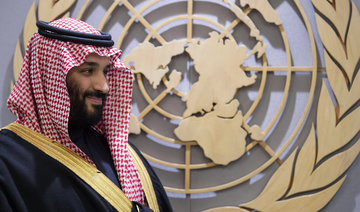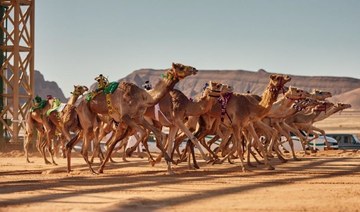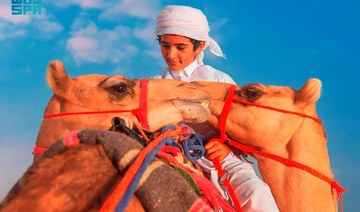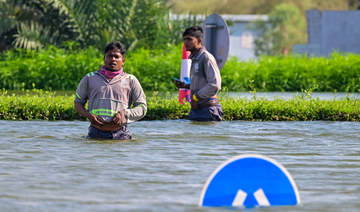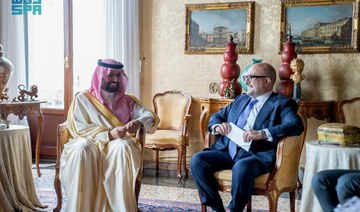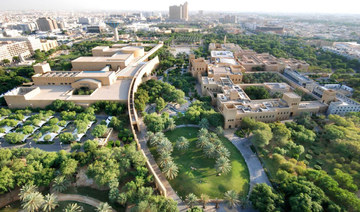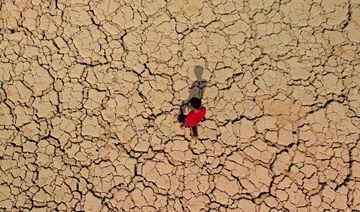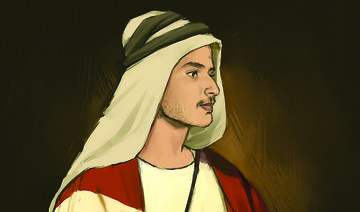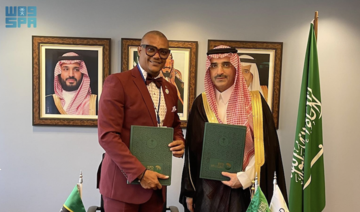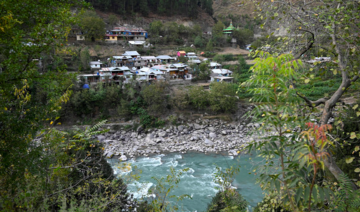PARIS: It is entirely feasible that Mohammed bin Salman and Emmanuel Macron can be friends. They have much in common.
Both are young men. The crown prince of Saudi Arabia is just 32, while Macron was 39 when he became his country’s youngest-ever president, and turned 40 only recently, in December.
On the earlier legs of his global tour, which has taken him to Britain, the US and Egypt, the prince’s dealings have all been with leaders who are old enough to be his parents. US President Donald Trump is 71, British Prime Minister Theresa May is 61 and Egyptian President Abdel Fattah El-Sisi is 63. Macron is of the prince’s generation.
Both are ambitious and both are in a hurry. The crown prince certainly makes no secret of it, telling Time magazine in a recent interview: “I don’t want to waste my time. I am young. ”
Vision 2030, Saudi Arabia’s wide-ranging plan for reforming its economy and society, is the prince’s brainchild, and though the name implies the notional target for the changes is 2030, it often seems that the prince does not want to wait that long.
Macron was so impatient for change in France — and so ambitious to be the one to implement it — that he announced his candidacy for president without bothering to court endorsement from any political party. Once a member of the Socialist party, he neither returned to that fold nor sought a place in another. Instead, he formed his own movement in April 2016, named it “En Marche!” (suitably dynamic, it translates loosely as “Let’s go!”) and got on with the task of winning over the country. Thirteen months later, he was elected president with 66 percent of the vote.
Mohammed bin Salman also acceded to his position as heir to his father, King Salman, through a vote. As he explained to Time magazine, he could not have become crown prince without the endorsement of the Allegiance Council, the body responsible for determining future succession to the throne of Saudi Arabia.
The council is made up of sons and grandsons of King Abdul Aziz, founder and first monarch of Saudi Arabia. Currently, there are 34 members.
“So I get the highest vote in the history of Saudi Arabia, more than anyone before me,” the prince told Time. “I got 31 from 34 votes of the Allegiance Council. So this is the highest.”
The next highest vote ever recorded was 22, he added.
Neither leader appears to have a great fear of upsetting sections of their domestic audience in the pursuit of radical reforms. In France, that is a guaranteed consequence of taking on the unions and challenging public-sector workers over their working hours or retirement age. French transport workers have been on strike for a week now.
But Macron is committed to reforming French labor laws, ridding the country of its reputation for inflexibility and old-style bosses-versus-unions confrontation and making France more business-friendly. 
Similarly, the crown prince is well aware that not everyone in Saudi Arabia approves of his reforms. But he also knows that his contemporaries, the young, who make up two-thirds of the population, are mostly with him.
So there should be much on which to build a strong rapport when Mohammed bin Salman arrives in Paris on Sunday night for a two-day visit.
The visit will concentrate on culture, tourism, investment and new technology. The prince is due to visit the French capital’s start-up hub, Station F. However, there has been no hint about new contracts to be signed.
Instead, Macron’s officers have spoken of a “new cooperation” with Saudi Arabia.
“We want a new cooperation, concentrating less on contracts and more on investing in the future, especially in digital and renewable energy, with a common vision,” is the word from the Elysée Palace.
The word “vision” is certainly one the crown prince understands well.
“I suspect the objective for the trip to France is pretty much the same as the visit to the US and the UK — to present Mohammed bin Salman as the future leader of Saudi Arabia and to highlight investment opportunities in an evolving economic and social environment there,” said Jerry Feierstein, director of Gulf affairs and government relations at the Middle East Institute.
“The Saudis have already announced a major deal with a French entertainment company to build movie theaters in the Kingdom. They may be interested in more French investment in the entertainment or tourism sectors.
“There may also be interest on both sides in discussing Saudi plans to develop their nuclear energy sector where the French have major capacity. Finally, there may be some discussion on defense purchases.”
As for Saudi Arabia, a source close to the royal delegation told AFP: “This is not a traditional state visit. It is about forging a new partnership with France, not just shopping for deals.”
Some observers view the visit as an expression of confidence by the prince.
AFP reports that more than a dozen memorandums of understanding are set to be signed between French and Saudi organizations in the fields of tourism, energy and transport. There is also scope for stronger cooperation on combating terrorism.
Experts say Macron also has to balance strengthening ties with Saudi Arabia with managing relations with other countries in the region, especially Iran. The prince’s sojourn in the US appears to have brought Riyadh and Washington closer together. President Donald Trump’s dislike of the Iran nuclear deal is well known.
Denis Bouchard of the French Institute of International Relations said Macron has to persuade Mohammed bin Salman that “it is better than have the 2015 nuclear agreement with Iran than no deal at all.”
The prince and the president have met once before, when Macron stopped off briefly at Riyadh airport en route to Abu Dhabi to weigh into the crisis sparked by the prime minister of Lebanon, Saad Hariri, announcing his resignation live on television from Saudi Arabia.
But Jerry Feierstein warned that for all the similarities between them it would be wrong to assume the crown prince and Macron will automatically become best friends. There are other contenders for that role, he said.
“Certainly Macron and Mohammed bin Salman would have more in common than with Trump, who is old enough to be the prince’s grandfather. But the crown prince does seem to have a close relationship with (Trump’s son-in-law) Jared Kushner, who is also closer in age.”
Unafraid of reform: The kindred spirits of Saudi crown prince and Macron
Unafraid of reform: The kindred spirits of Saudi crown prince and Macron
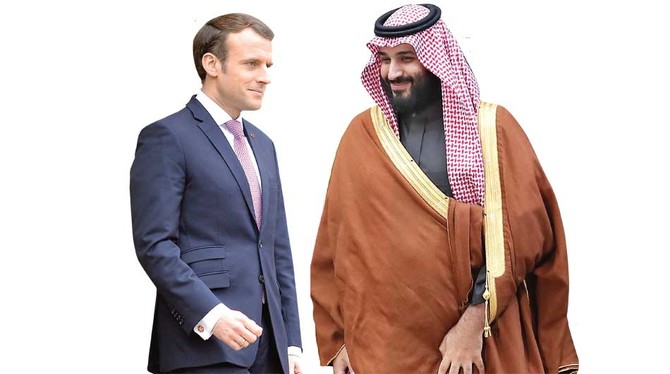
- More than a dozen memorandums of understanding are set to be signed between French and Saudi organizations.
- Saudis announced a major deal with a French entertainment company.
Saudi Arabia takes part in 3rd annual international Camel Parade in Paris
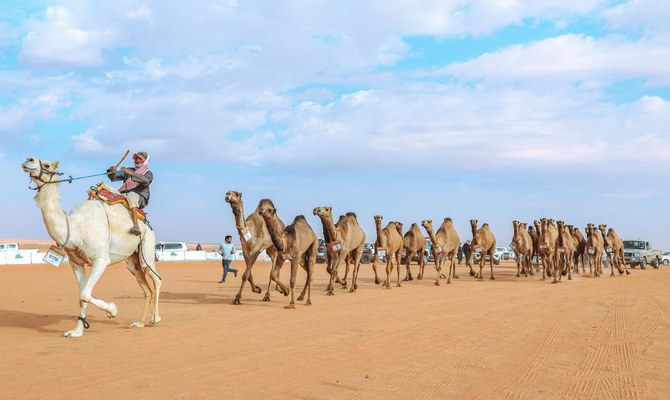
- This year’s event celebrates decision by the UN Food and Agriculture Organization to designate 2024 as International Year of Camelids
- Saudi representatives will highlight role of the Kingdom in promoting the value of camels as a cultural symbol associated with Saudi society since ancient times
RIYADH: Saudi Arabia is taking part in a special Camel Parade in France on Saturday, in celebration of the UN’s designation of 2024 as International Year of Camelids.
The event in Paris has been organized by the French Federation for the Development of Camelids in France and Europe, under the umbrella of the International Camel Organization, and is sponsored by the Saudi Ministry of Culture and the Kingdom’s Camel Club.
This is the third year in which the event has taken place. The event was first held in January 2019 and repeated in 2022.
The participants in the parade of camels, llamas, alpacas and other members of the camelid family of creatures are expected to include more than 50 representatives of camel-related organizations from more than 30 countries, along with camel breeders, government officials, others with an interest in the animals, and entertainers from various branches of the performing arts.
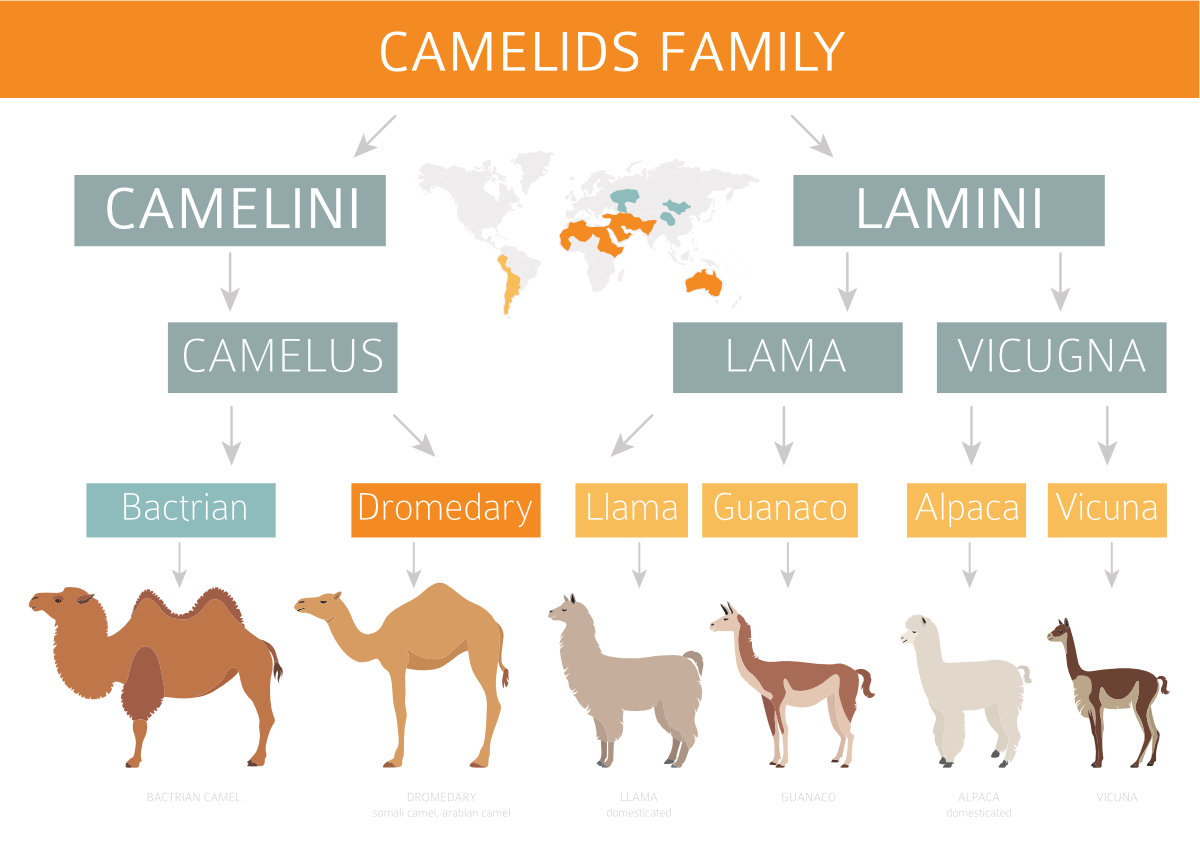
In addition to Saudi Arabia, the countries that will be represented include the US, the UAE, Qatar, Oman, Bahrain, Canada, India, Morocco, Tanzania, Peru, Algeria, the Czech Republic, Pakistan, Tunisia, Austria, Spain, Burundi, Senegal, the Democratic Republic of the Congo, Mauritania, France, Sudan, Chad, Angola, the UK and Uganda.
Saudi representatives will highlight the role of the Kingdom in promoting the value of camels as a cultural symbol that has been associated with Saudi society since ancient times and “still enjoys great prestige,” the Saudi Press Agency reported.
On Friday, the eve of the parade, public discussions took place at the Chateau de Janvry’s historical center about cultural heritage associated with camels around the world and the specific contributions by participating countries to the annual event in Paris.
The parade will be followed by a reception for invited guests, including representatives of the participating countries, international organizations, academia, research centers and the private sector, the SPA reported.
The UN Food and Agriculture Organization named 2024 as International Year of Camelids to honor and promote the sector and highlight the important role it plays in efforts to achieve food security and economic growth in many countries.
Saudi assistant defense minister holds talks with Pakistan’s top military officials in Islamabad
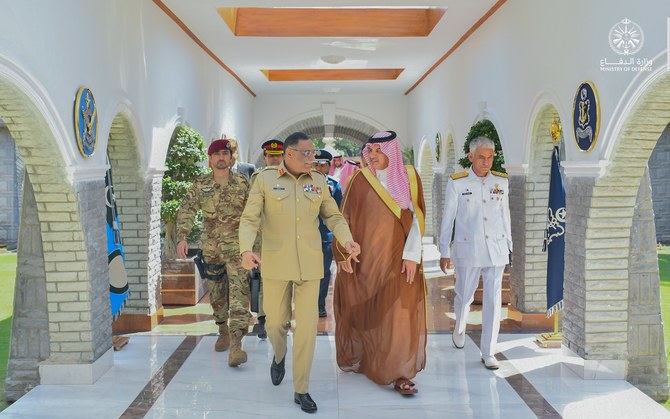
RIYADH: Saudi Arabia’s assistant minister of defense, Talal Al-Otaibi, on Friday held talks with top officials from the Pakistan Army during an official visit to Islamabad.
He reviewed relations between the two countries during meetings with the commander of the army, Gen. Syed Asim Munir, the head of the Joint Chiefs of Staff, Gen. Sahir Shamshad Mirza, and the chief of the general staff, Gen. Muhammad Avais Dastgir.
The Saudi-Pakistani Committee also met during Al-Otaibi’s visit. Its members discussed cooperation between the nations in the field of defense, including research and development, and the transfer and localization of technology, in line with the goals of Kingdom’s Vision 2030 development and diversification plan.
How the adoption of electric vehicles is driving Saudi Arabia’s green agenda
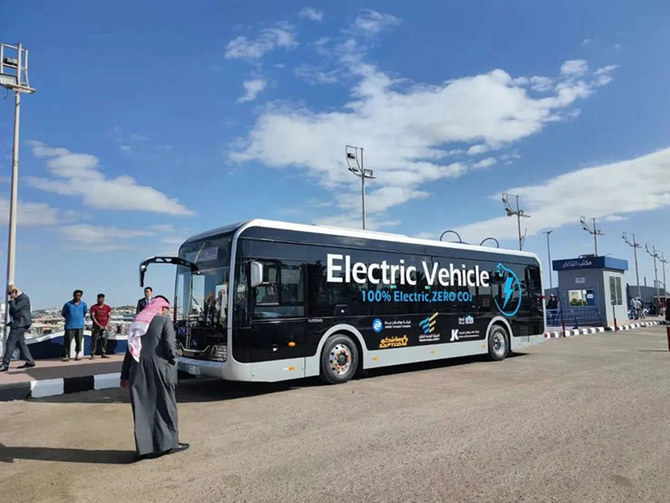
- Saudi Arabia’s Public Investment Fund wants to produce half a million electric vehicles by 2030
- The Kingdom has installed charging outlets in public areas in Diriyah to encourage EV ownership
RIYADH: Around the world, electric vehicles are already revolutionizing leisure, public transportation and logistics, shrinking the carbon footprint of travel, improving air quality and reducing pollution in the air, on land and in the sea.
As Saudi Arabia embarks on a range of environmental initiatives designed to address the challenges posed by climate change and foster sustainable economic development, EVs have become an important focus area.
The shift from traditional combustion engine vehicles to new electric models has accelerated worldwide as companies and consumers opt for greener modes of transport. Saudi Arabia is no exception.
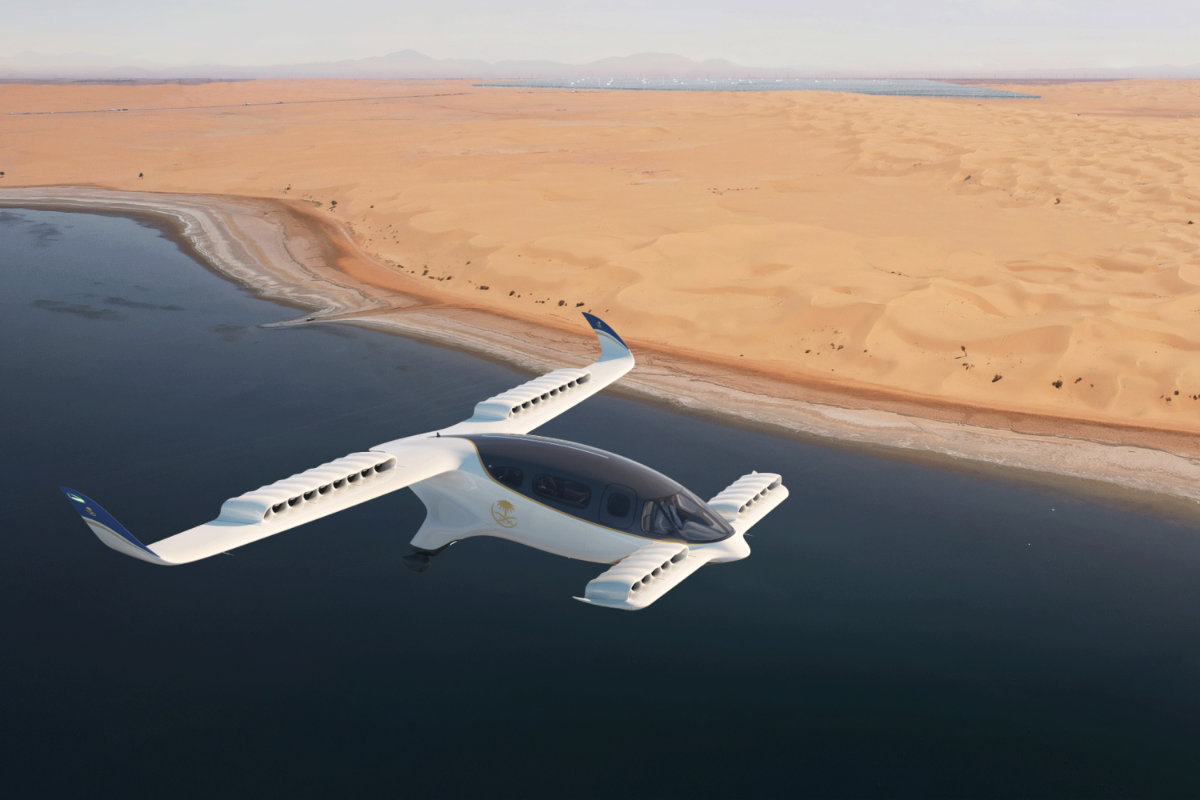
The transition from regular cars to electric vehicles in the Kingdom is flourishing. The EV trend has gone beyond personal vehicle ownership, with the proliferation of everything from e-scooters to electric buses.
There are even discussions around whether EV technology will soon be applied to aircraft and perhaps space travel.
Stephen Crolius, former climate adviser at the Clinton Foundation and current president of Carbon-Neutral Consulting, supports the idea of EV ownership due to its environmental benefits.
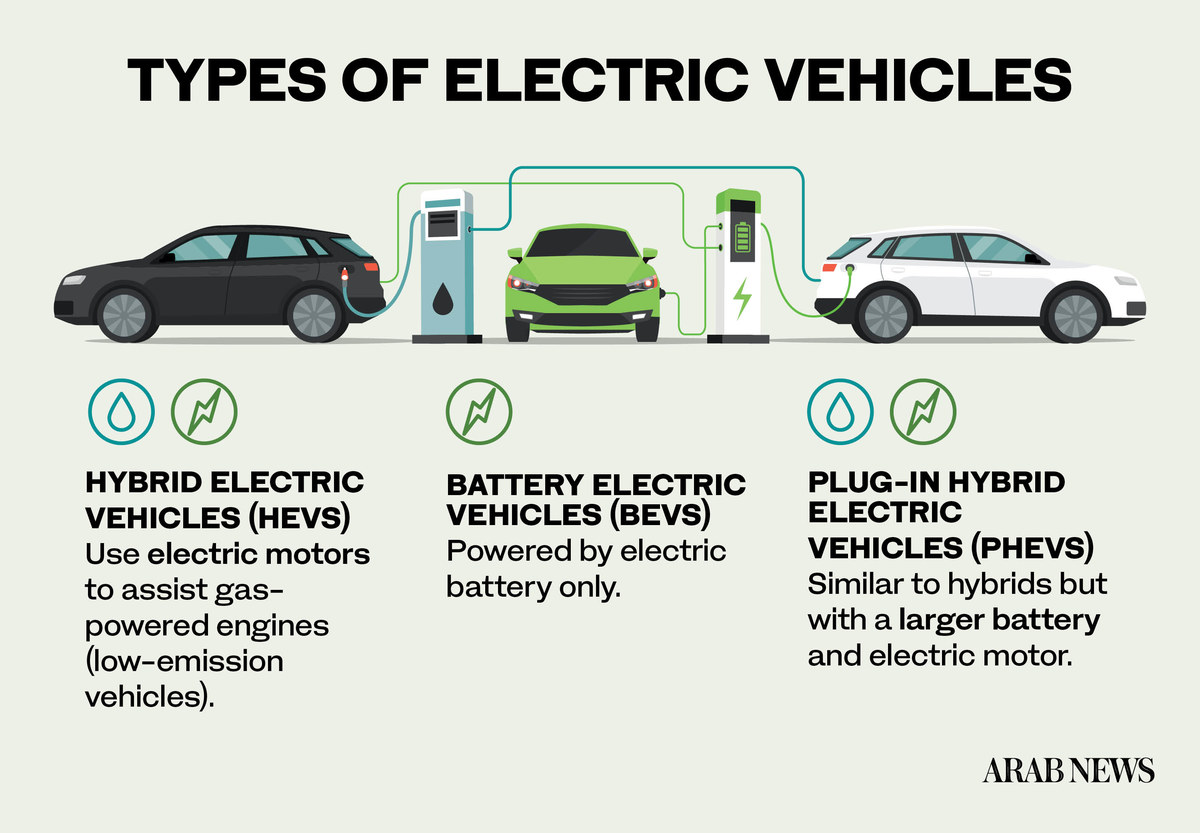
Although it might still be a challenge to educate the public in some societies about the benefits of transitioning to EVs, Crolius says the advantages outweigh the disadvantages.
“For mass transition to occur on any front, there has to be a set of circumstances that cause it to happen,” he told Arab News.
“Through government encouragement, we can continue to build volume (and) cause industries to mature, like, for example, the battery industry, which has done a lot of maturing over the last 15 years … the cost of batteries and the prices of batteries have come down to an extraordinary degree.
Opinion
This section contains relevant reference points, placed in (Opinion field)
“We are developing renewable generation for electricity. Are we developing fast enough to head off the climate crisis? I don’t know. But compared to new generations of technology getting rolled out, we are deploying a lot of renewable electricity generation, in historical terms, really fast.”
Companies such as CEER and Lucid, which are heavily funded by the Saudi Public Investment Fund, are at the forefront of driving growth in Saudi Arabia’s electric vehicle industry.
US electric car manufacturer Lucid signed a contract with the PIF two years ago to build a factory in the King Abdullah Economic City on the Red Sea. Today, PIF shares a little over half of the ownership of the group in the Kingdom, and aims to produce almost half a million EVs by 2030.
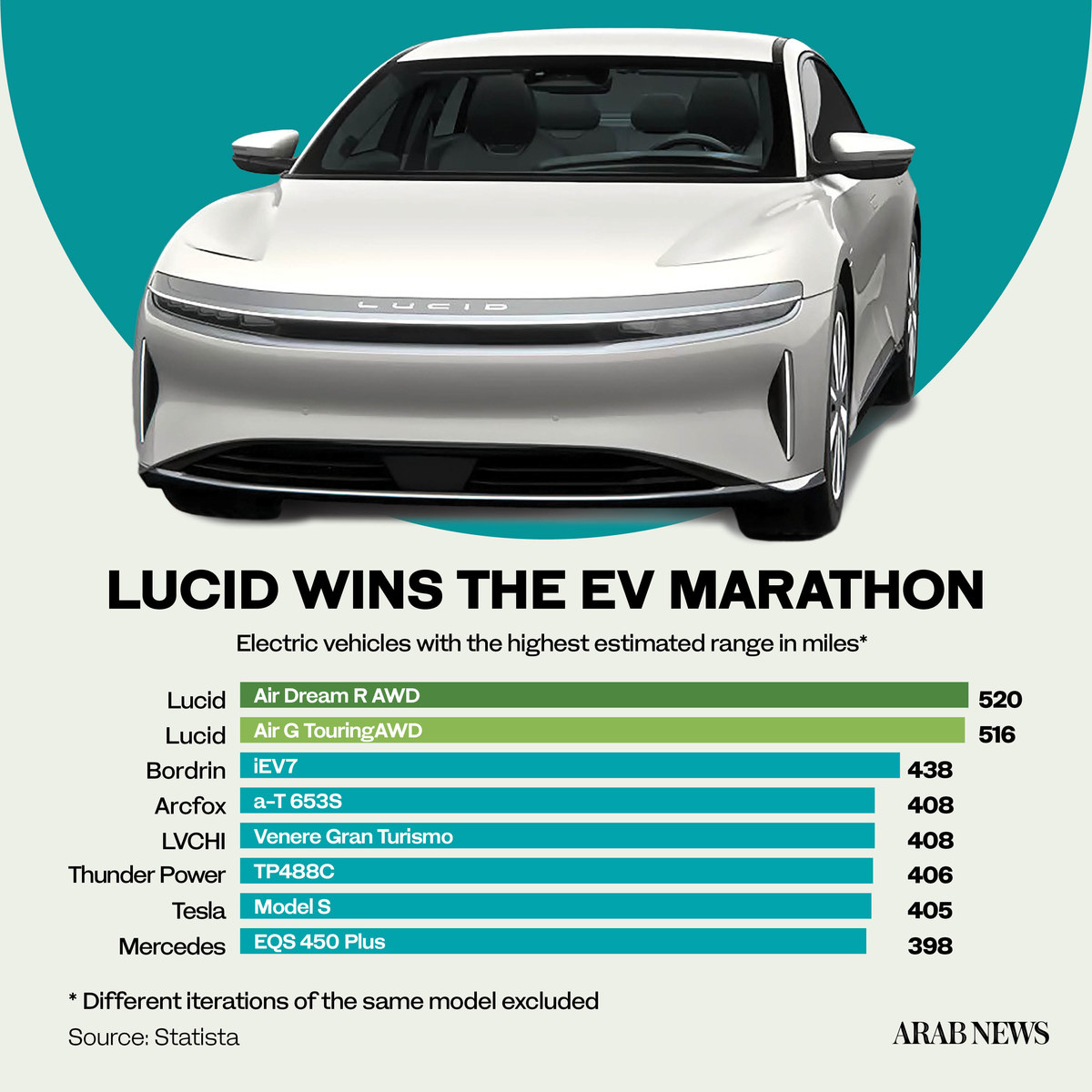
Since last year, the use of electric vehicles in the Kingdom has expanded to include electric buses as a sustainable alternative to traditional fossil fuel-powered vehicles.
Electric buses have zero emissions and therefore significantly reduce air pollution and greenhouse gases in urban areas, especially during the Hajj season, when pilgrims flock to the Kingdom and make use of its mass transit network.
An electric bus service connecting the airport to the Prophet’s Mosque in Madinah was launched by the region’s governor Prince Faisal bin Salman bin Abdulaziz during the last Hajj season.
DID YOUKNOW
• The Kingdom has invested at least $10 billion in US electric car manufacturer Lucid Motors.
• With 61% of shares, Saudi Arabia is the majority owner of Lucid Group through its Public Investment Fund.
• PIF aims to produce 500,000 EVs annually by 2030.
• In Riyadh, the EV share is targeted to increase by 30% in 2030.
The route connecting the two locations enabled high operational efficiency, with a bus able to travel 250 km on just a single charge.
Electric buses offer a variety of benefits, including reduced noise, improved energy efficiency and lower maintenance costs. In addition, they have a smaller carbon footprint, which is a crucial step toward sustainability.
Saudis committed to protecting the environment have also included EVs in their daily commute, with e-scooters now found in Riyadh and other cities. E-scooters provide an eco-friendly solution to local transport by cutting toxic emissions and lowering noise pollution.
Offering e-scooter services in various locations in Riyadh is a clear sign of the Kingdom’s eagerness to not only set regulations and promote electric vehicles, but also lead society in adopting a positive attitude toward sustainable living.
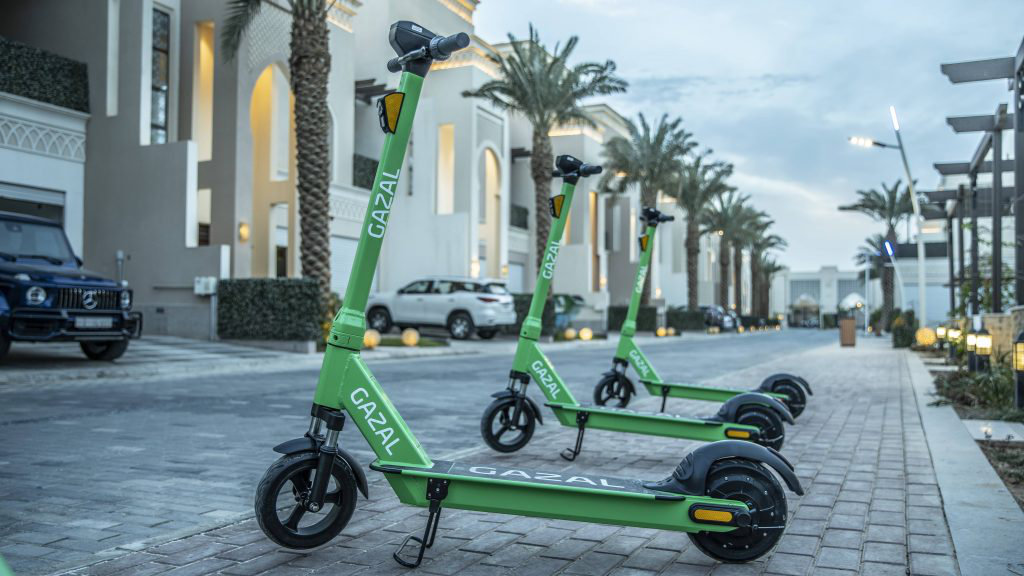
Furthermore, with advancements in battery technology and the development of charging infrastructure, electric vehicles are becoming a viable option for companies aiming to decarbonize their operations.
For example, in public areas in Diriyah such as Albujairi and At-Turaif, standard wall outlets are available for EV owners to charge their vehicles while enjoying a visit to the UNESCO World Heritage site.
As the aviation industry is one of the largest contributors to carbon emissions, the concept of electric aircraft may offer a promising solution to global decarbonization.
Three years ago, British automobile maker Rolls-Royce broke records when its “Spirit of Innovation” aircraft reached 628 km per hour, making it the world’s fastest all-electric vehicle.
At the time, Warren East, the company’s then-CEO, said that electric aircraft could make “jet zero” a reality and help decarbonize all forms of transport.
Compared to existing commercial aircraft, which rely on petroleum and synthetic fuel blends, electric planes produce less noise, have lower operating costs and emit significantly fewer greenhouse gases.
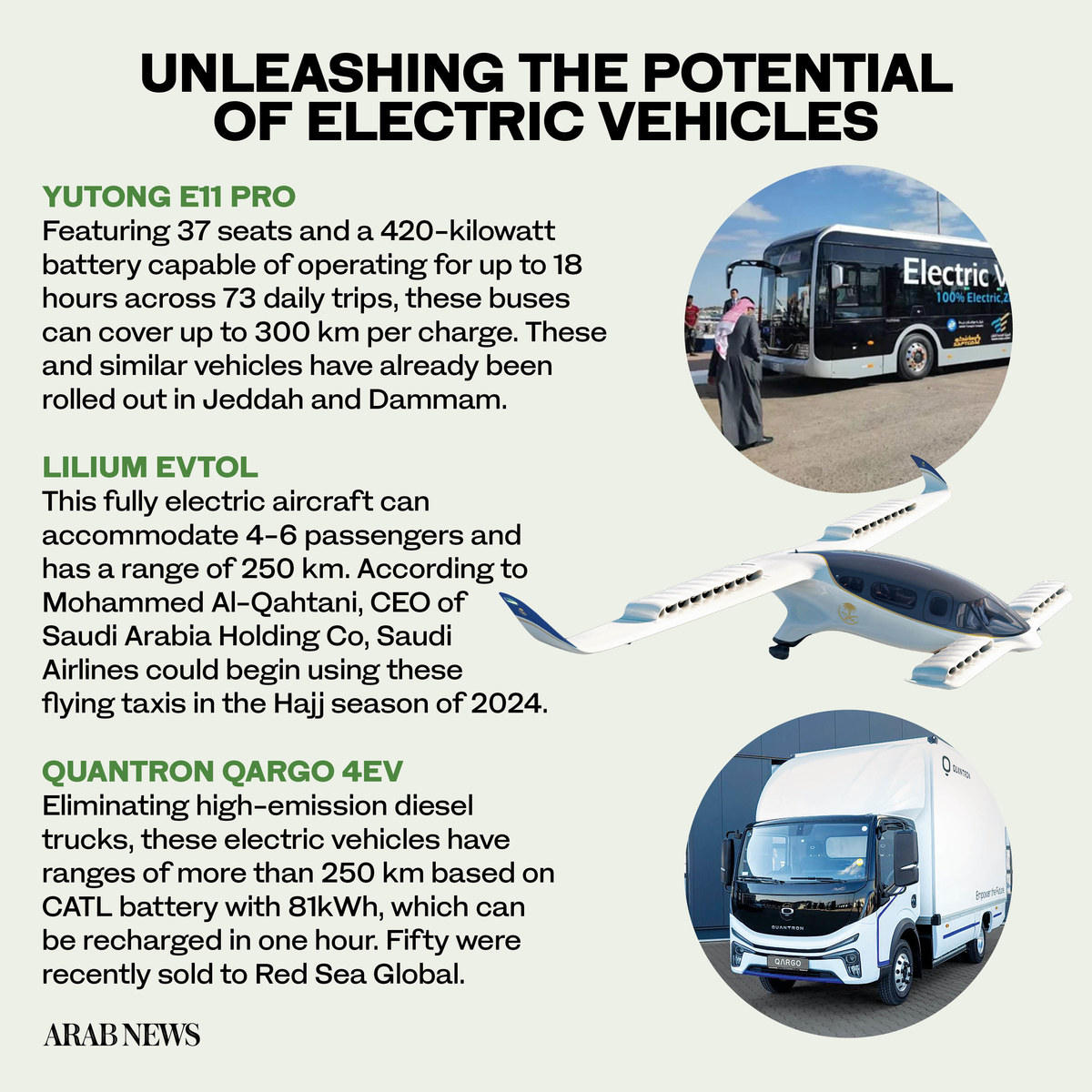
However, there are still several obstacles to the widespread adoption of electric aircraft — in particular the sheer expense of adapting the existing infrastructure needed to support their use.
Though governments and private companies worldwide could collaborate and build a comprehensive network of charging stations to meet growing demand, this may burden the economies of some countries.
Nevertheless, the growing importance of electric vehicles beyond cars, such as buses, electric scooters and airplanes, holds great promise for a decarbonized future.
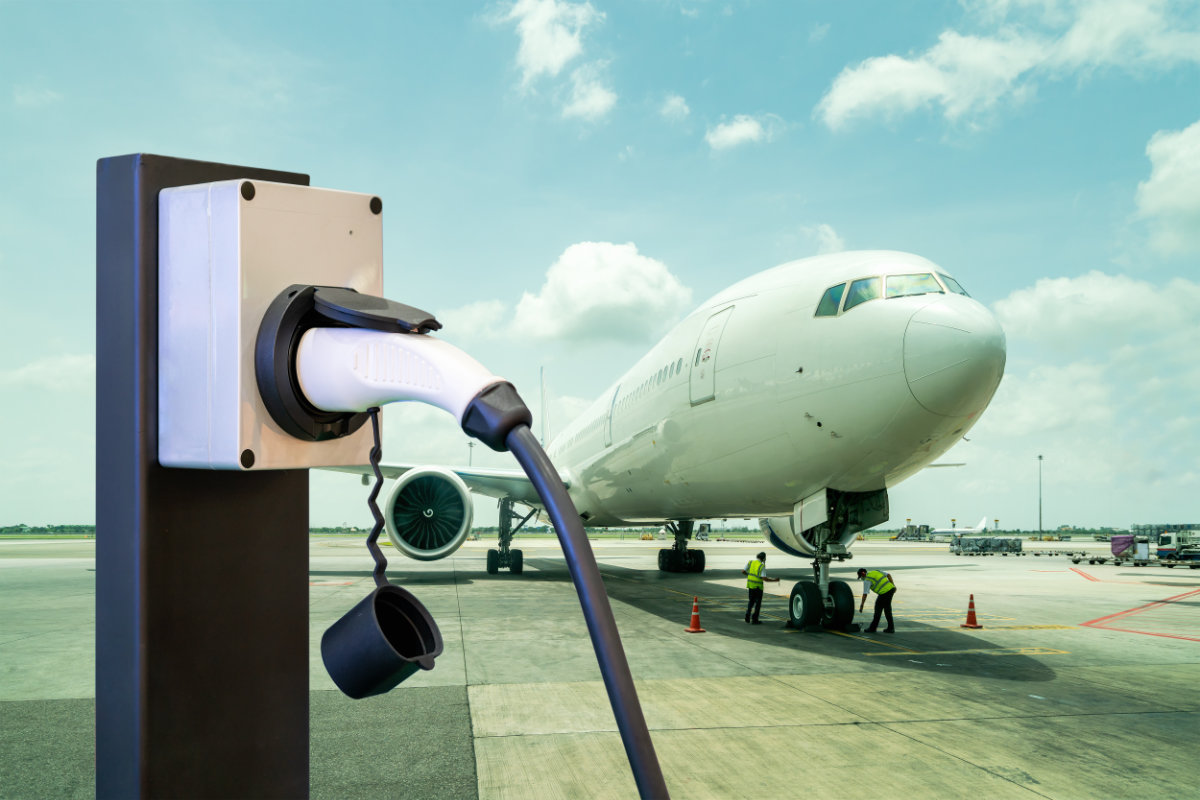
Utilizing alternative sources of energy in these areas can change the carbon emissions game for the better, fight air pollution, and pave the way for sustainable transport systems in the Kingdom and around the world.
To realize the full potential of electric vehicles, however, governments and businesses will first have to address challenges such as the provision of sufficient charging infrastructure as well as range limitations in battery technology.
Through continued innovation and investment, electric vehicles will play a key role in creating a greener and more sustainable future.
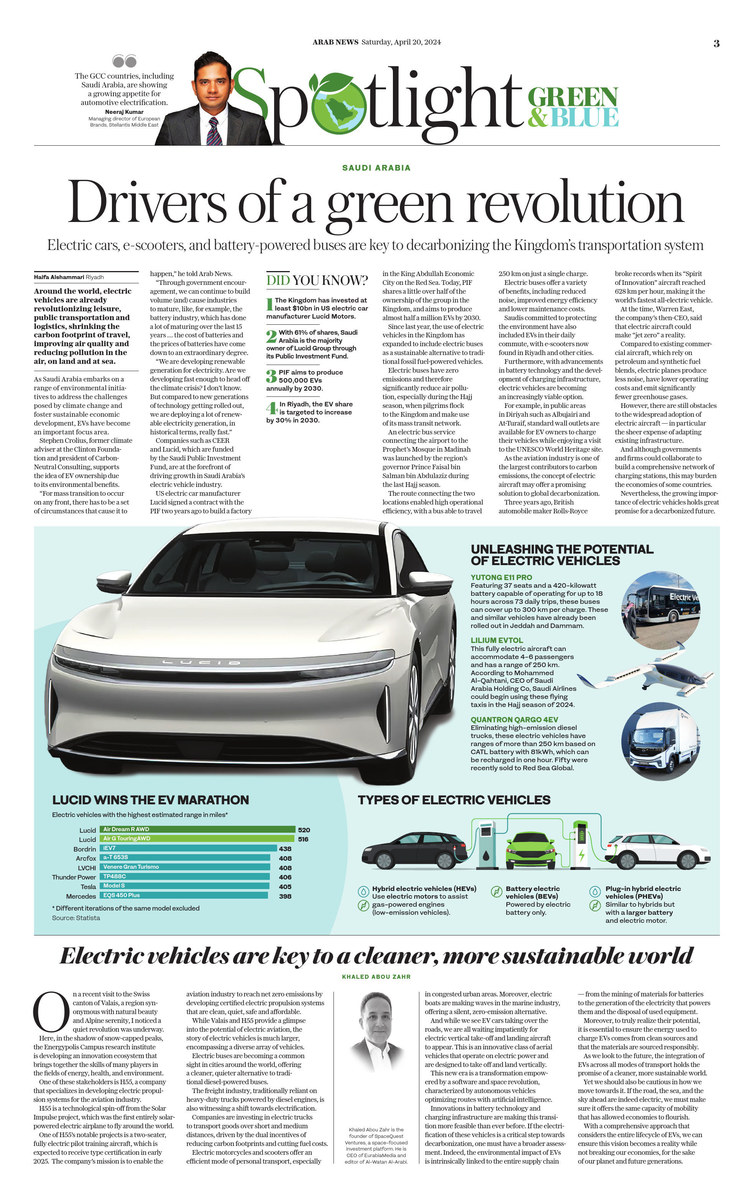
Art is ‘translating feelings,’ says 16-year-old Saudi artist
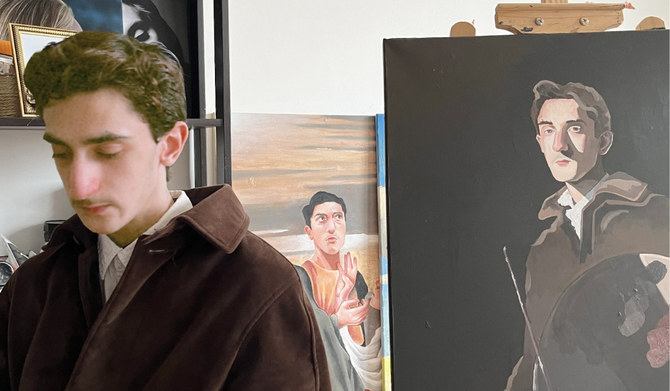
- Jawad Al-Omair has established himself as a painter, drawing inspiration from the beauty and pain surrounding him
RIYADH: While his classmates took part in sports activities, Saudi teenage artist Jawad Al-Omair daydreamed about the next time he would pick up a paintbrush or pencil to draw again.
At only 16 years of age, Al-Omair has established himself as an artist, drawing inspiration from the beauty and pain surrounding him.
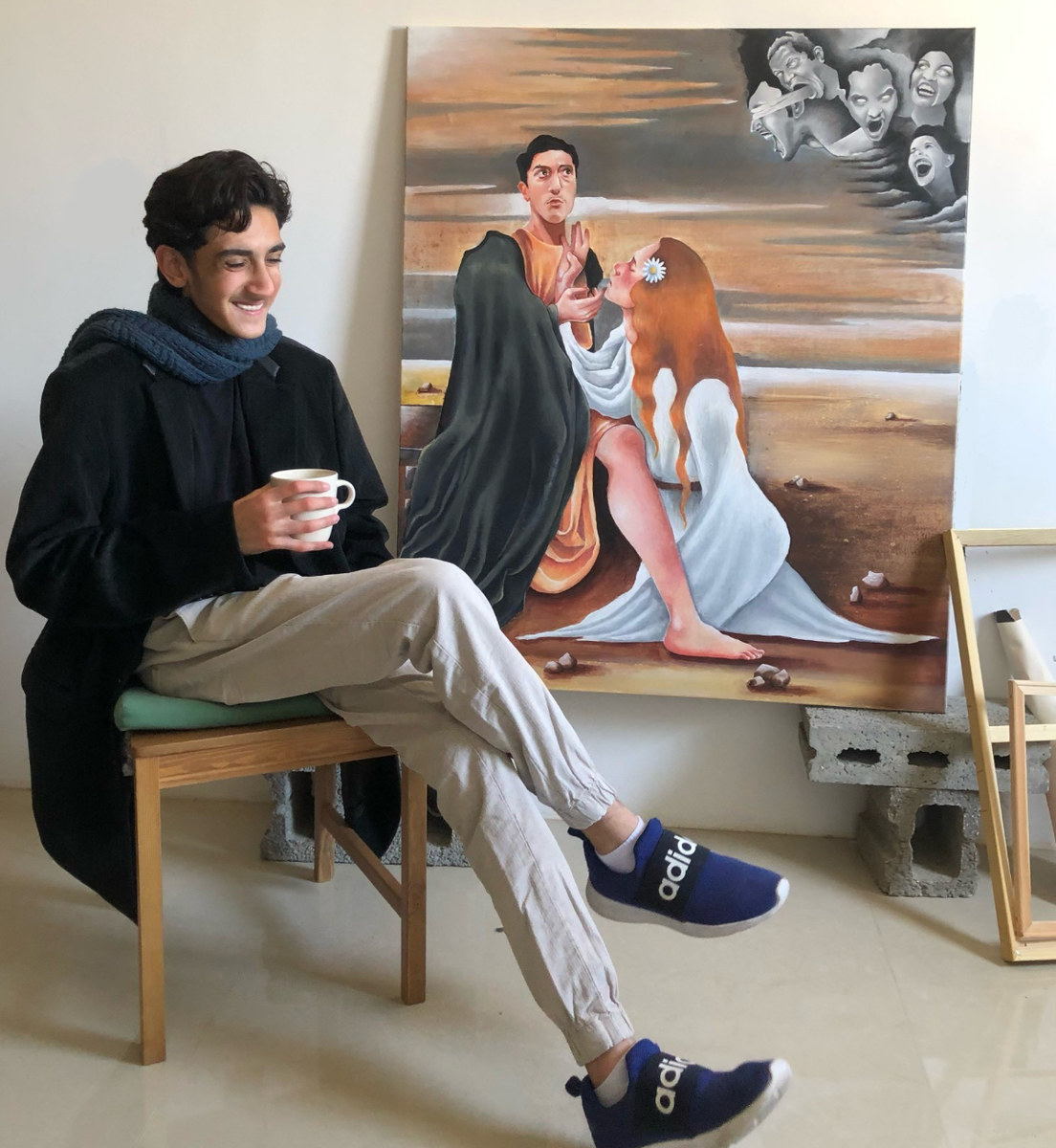
He told Arab News that his breakthrough moment came when he discovered his artistic abilities in the third grade.
“All the kids used to go to play. I always found myself opening my notebook and just drawing. I remember one day, I drew something at school, and when I got home, I showed it to everyone. I told myself, ‘I should do this more often.’”
HIGHLIGHT
Jawad Al-Omair views color as an arsenal to communicate emotion in his artworks.
He uses acrylic paint to portray his vivid ideas on canvas.
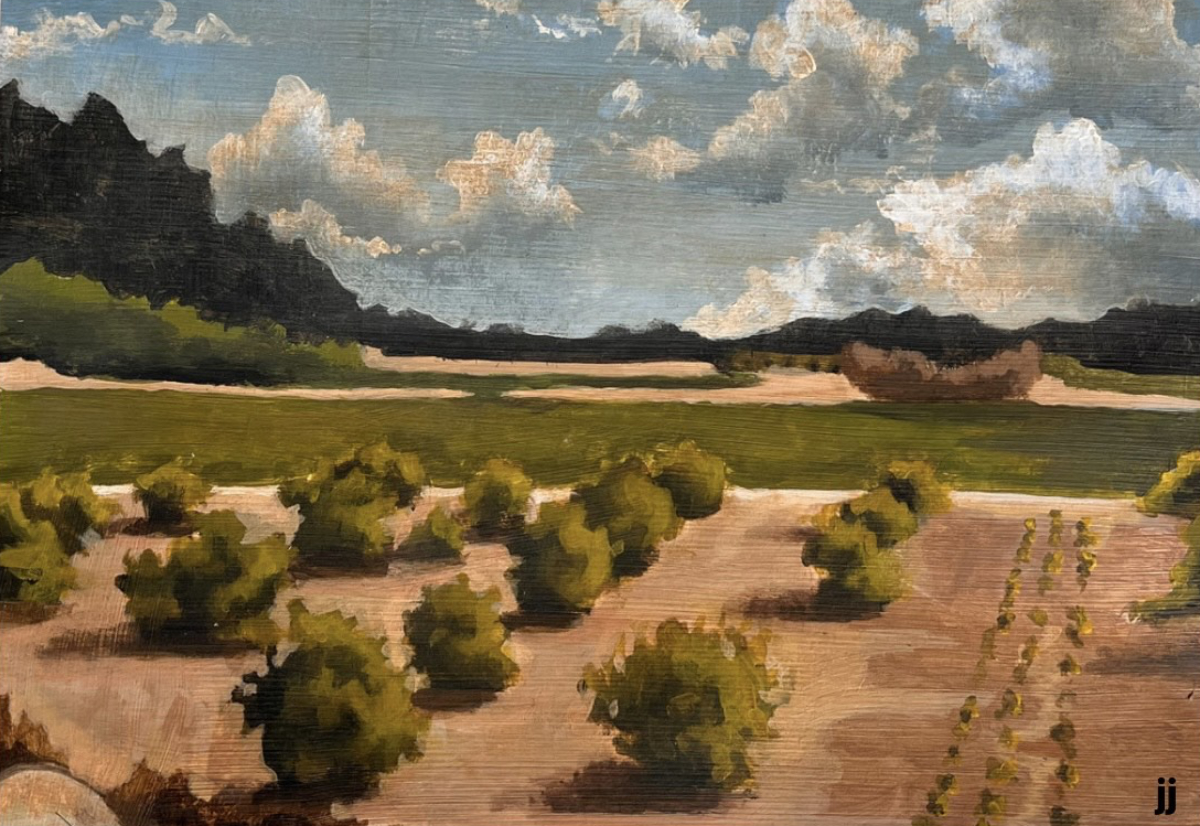
“With every painting I do, I usually have a vision of what the color palette is going to be and the composition, and most importantly what message and feeling I am trying to deliver through the painting.”
The young artist views color as an arsenal to communicate emotion in his artworks. “If I wanted to paint something that conveys the feeling of being lost, I would usually use cool toned colors like greys and blues.”

Al-Omair said that he noticed a dramatic change in his artistic abilities after being introduced to a group of local artists who taught him painting techniques to implement in his artworks.
“Dana Almasoud is one of my best friends who has helped me so much. Three years ago, I used to be a completely different artist. I used to be unable to draw small portraits, but she taught me how to. I can’t picture how my life would be if I had not met them,” he said.
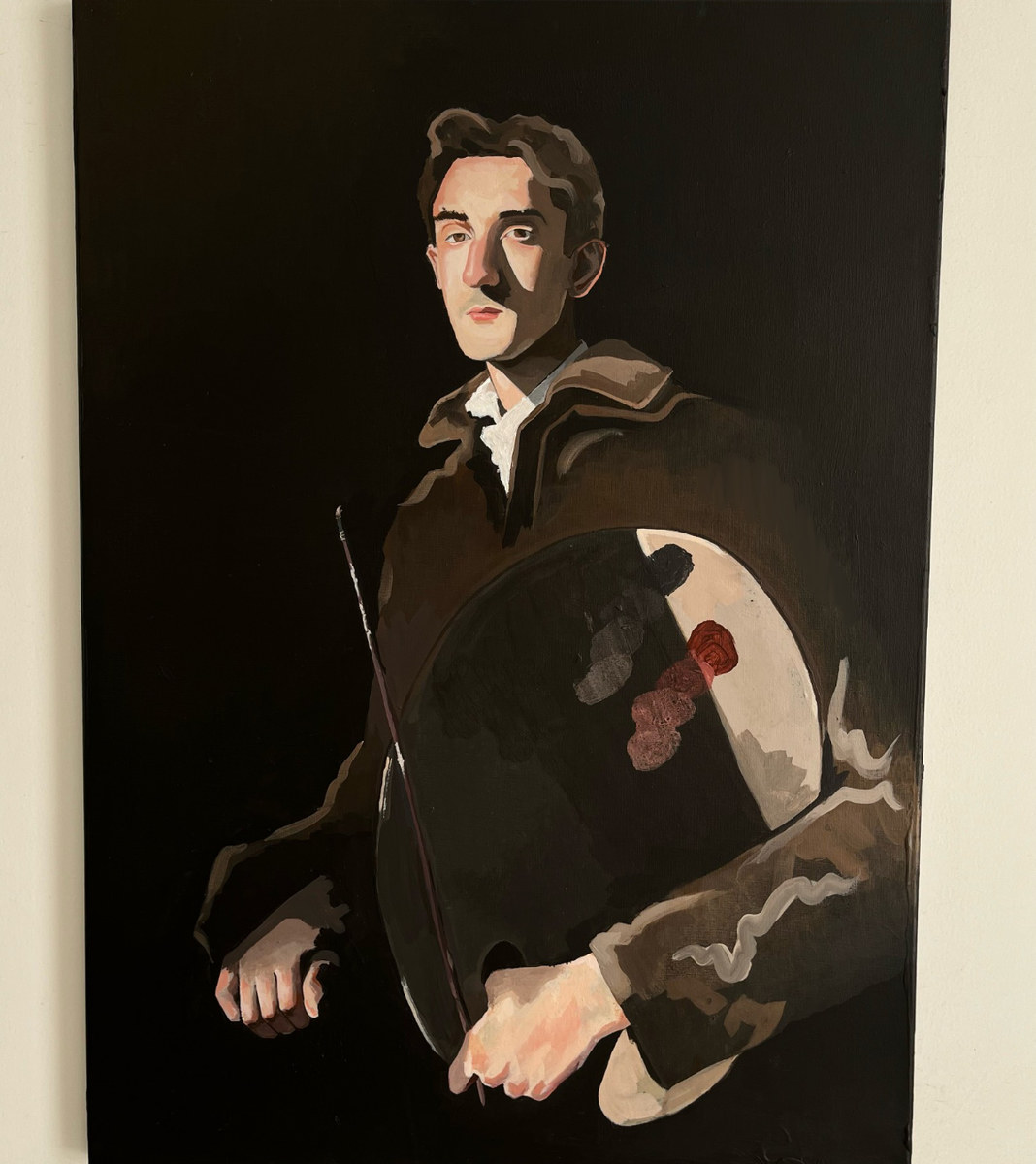
In a recent artwork, Al-Omair painted a large-scale self-portrait inspired by the style of John Singer Sargent, an American artist renowned for his portrait paintings in the late 19th and early 20th centuries.
He described Sargent as one of his favorite artists. “If you see his self-portrait, It is similar to mine. I was looking at his artwork while I was painting so I could capture that same vibe.”
It took Al-Omair about 12 hours to complete the self-portrait, which emphasizes his prominent features.
“I get commented on my nose a lot, so I painted it in the center. I wanted to immortalize my 16-year-old self, because who knows what I will look like five years from now?”
The young artist aims to turn all sorts of experiences — even those of friends or family members — into art.
“How would life be if we did not have music or anything beautiful to look at? When you think of an artist, people usually imagine someone with a brush, but it is much bigger than that.
“Art is translating feelings with a certain skill. Movies taught humanity so much because you get to learn about people. Writing, songs and music are emotional things that we share. Art is one of the most important parts of life. Everyone has an artistic side to them that they may have not found yet,” he said.
Saudi development fund agrees $50m loan deal with St. Vincent and the Grenadines
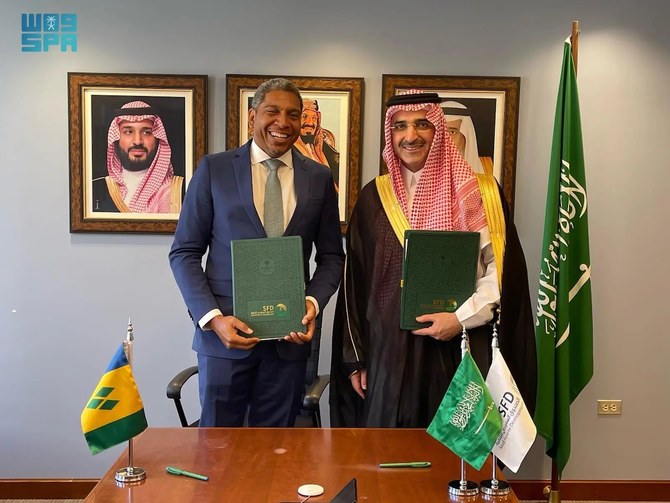
- Funding will help rebuild and repair facilities damaged by natural disasters in the Caribbean island nation
RIYADH: The Saudi Fund for Development signed a $50 million loan agreement with St. Vincent and the Grenadines on Friday to assist communities affected by natural disasters, Saudi Press Agency reported.
The deal was signed by SFD CEO Sultan Abdulrahman Al-Marshad and Camillo Gonsalves, finance minister of St. Vincent and the Grenadines, during the 2024 spring meetings of the World Bank and the International Monetary Fund in Washington.
According to the World Bank, the southern Caribbean nation faces a host of natural threats, including floods, hurricanes, droughts, landslides, and volcanic eruptions.
The agreement will fund a project to rebuild and repair buildings and facilities damaged by natural disasters in the island nation.
This initiative includes the restoration and construction of essential infrastructure, such as housing, healthcare, educational, and sports facilities, aimed at boosting their durability and resilience against future disasters and climate change impacts.
The project will also include establishing four healthcare centers, building primary and secondary schools, renovating government buildings, and restoring homes damaged by volcanic activity.
The loan is in line with the SFD’s commitment to supporting vulnerable communities around the globe.
Since its inception in 1975, the Saudi fund has financed over 800 development projects and programs worldwide, with total funding exceeding $20 billion.



